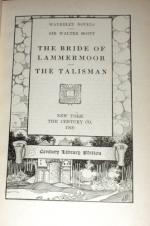The Master of Ravenswood had some difficulty to compose the terrors of the poor child, whom his unexpected appearance had at first rather appalled than comforted; and when he succeeded, the first expression which the girl used intimated that “he had come too late.” Upon inquiring the meaning of this expression, he learned that the deceased, upon the first attack of the mortal agony, had sent a peasant to the castle to beseech an interview of the Master of Ravenswood, and had expressed the utmost impatience for his return. But the messengers of the poor are tardy and negligent: the fellow had not reached the castle, as was afterwards learned, until Ravenswood had left it, and had then found too much amusement among the retinue of the strangers to return in any haste to the cottage of Alice. Meantime her anxiety of mind seemed to increase with the agony of her body; and, to use the phrase of Babie, her only attendant, “she prayed powerfully that she might see her master’s son once more, and renew her warning.” She died just as the clock in the distant village tolled one; and Ravenswood remembered, with internal shuddering, that he had heard the chime sound through the wood just before he had seen what he was now much disposed to consider as the spectre of the deceased.
It was necessary, as well from his respect to the departed as in common humanity to her terrified attendant, that he should take some measures to relieve the girl from her distressing situation. The deceased, he understood, had expressed a desire to be buried in a solitary churchyard, near the little inn of the Tod’s Hole, called the Hermitage, or more commonly Armitage, in which lay interred some of the Ravenswood family, and many of their followers. Ravenswood conceived it his duty to gratify this predilection, commonly found to exist among the Scottish peasantry, and despatched Babie to the neighbouring village to procure the assistance of some females, assuring her that, in the mean while, he would himself remain with the dead body, which, as in Thessaly of old, it is accounted highly unfit to leave without a watch.
Thus, in the course of a quarter of an hour or little more, he found himself sitting a solitary guard over the inanimate corpse of her whose dismissed spirit, unless his eyes had strangely deceived him, had so recently manifested itself before him. Notwithstanding his natural courage, the Master was considerably affected by a concurrence of circumstances so extraordinary. “She died expressing her eager desire to see me. Can it be, then,” was his natural course of reflection—“can strong and earnest wishes, formed during the last agony of nature, survive its catastrophe, surmount the awful bounds of the spiritual world, and place before us its inhabitants in the hues and colouring of life? And why was that manifested to the eye which could not unfold its tale to the ear? and wherefore should a breach be made in the laws of nature, yet its purpose remain unknown? Vain questions, which only death, when it shall make me like the pale and withered form before me, can ever resolve.”




